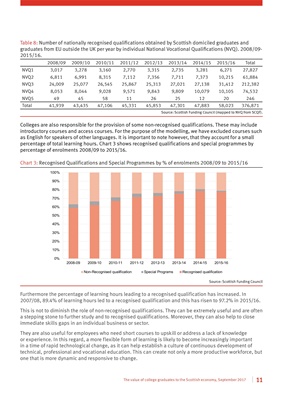
11
The value of college graduates to the Scottish economy, September 2017
Table 8: Number of nationally recognised qualifications obtained by Scottish domiciled graduates and
graduates from EU outside the UK per year by individual National Vocational Qualifications (NVQ). 2008/09-
2015/16.
2008/09 2009/10 2010/11 2011/12 2012/13 2013/14 2014/15 2015/16 Total
NVQ1 3,017 3,278 3,160 2,770 3,315 2,735 3,281 6,271 27,827
NVQ2 6,811 6,991 8,315 7,112 7,356 7,711 7,373 10,215 61,884
NVQ3 24,009 25,077 26,545 25,867 25,313 27,021 27,138 31,412 212,382
NVQ4 8,053 8,044 9,028 9,571 9,843 9,809 10,079 10,105 74,532
NVQ5 49 45 58 11 26 25 12 20 246
Total 41,939 43,435 47,106 45,331 45,853 47,301 47,883 58,023 376,871
Source: Scottish Funding Council (mapped to NVQ from SCQF).
Colleges are also responsible for the provision of some non-recognised qualifications. These may include
introductory courses and access courses. For the purpose of the modelling, we have excluded courses such
as English for speakers of other languages. It is important to note however, that they account for a small
percentage of total learning hours. Chart 3 shows recognised qualifications and special programmes by
percentage of enrolments 2008/09 to 2015/16.
Chart 3: Recognised Qualifications and Special Programmes by % of enrolments 2008/09 to 2015/16
0%
10%
20%
30%
40%
50%
60%
70%
80%
90%
100%
2008-09 2009-10 2010-11 2011-12 2012-13 2013-14 2014-15 2015-16
Non-Recognised qualification Special Programs Recognised qualification
Source: Scottish Funding Council
Furthermore the percentage of learning hours leading to a recognised qualification has increased. In
2007/08, 89.4% of learning hours led to a recognised qualification and this has risen to 97.2% in 2015/16.
This is not to diminish the role of non-recognised qualifications. They can be extremely useful and are often
a stepping stone to further study and to recognised qualifications. Moreover, they can also help to close
immediate skills gaps in an individual business or sector.
They are also useful for employees who need short courses to upskill or address a lack of knowledge
or experience. In this regard, a more flexible form of learning is likely to become increasingly important
in a time of rapid technological change, as it can help establish a culture of continuous development of
technical, professional and vocational education. This can create not only a more productive workforce, but
one that is more dynamic and responsive to change.